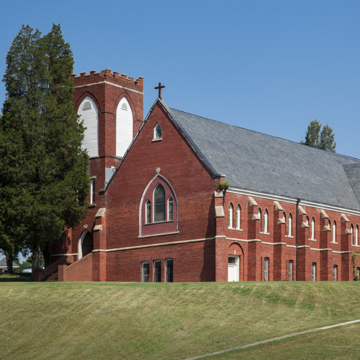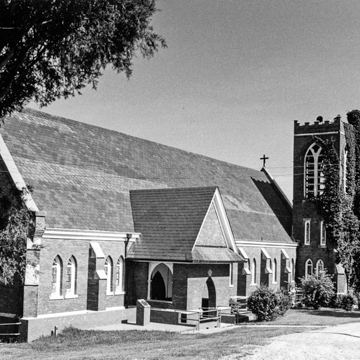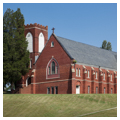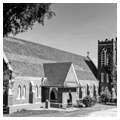You are here
St. Paul's College (St. Paul's Normal and Industrial School)
In 1882, the Reverend James Solomon Russell arrived in Lawrenceville to organize the county's small black Episcopal congregation. Born a slave in Mecklenburg County, Russell was a newly ordained minister from the Branch Theological Seminary in Petersburg, where he studied under the Reverend Giles Buckner Cooke, a major in the Confederate army who became a builder of Episcopal schools for emancipated youth. St. Andrew's Episcopal Church (1829; c. 1911 modifications; 400 Windsor Avenue), a church with a white congregation, was the first place the black congregation could find to worship. This small frame building was redesigned shortly after 1910 when the bell tower was added, the church's orientation was reversed to accommodate a road change, and a modest vestibule was added.
Russell and his congregation of African Americans organized a parochial school that, with some help from the Episcopal Diocesan Council and Northern donors, led to the creation of St. Paul's Normal and Industrial School. The coeducational St. Paul's began by teaching basic skills, helping prepare teachers, and emphasizing technical training. According to Russell in his Adventure in Faith (1936), he was roundly criticized by whites for “educating Negroes away from manual labor” and by blacks for offering industrial education. The Saul Building (1888, near the chapel) housed the early school. This two-bay two-story frame structure was built with funds donated by the Reverend James Saul of Philadelphia. Slowly, more land was acquired, including Rose Creek, one of four Brunswick County plantations once owned by John Hartwell Cocke of Bremo in Fluvanna County. The slaves lived in rammed earth, or pise, houses. Russell wrote that Rose Hill was a “sort of supply station for the breeding and training of slaves, from whence they were sent to other plantations as needed.”
St. Paul's Memorial Chapel (1904) was built by the school's students, thus demonstrating the technical skills taught at the school, with funds from the Diocese of Long Island. The Gothic Revival brick church, set on a high basement, has its arched entrance in a battlemented, corner bell tower with a projecting round corner turret. The parapeted main facade with angled corner buttresses features a triple window and twin pointed-arched windows on the side elevations are framed by buttresses with rough-faced stone.
The large frame president's house (c. 1900) is L-shaped with an elaborate porch in the reentrant angle and paired windows below segmental-arched heads. Emery Dormitory (1929) was designed by Virginia's leading scholastic architect of the era, Charles M. Robinson of Richmond. Illustrating the burgeoning growth of the school, this handsome brick dormitory is three-and-a-half stories in height and thirteen bays long. Surmounted by jack arches, the windows of the first floor are set in the shallow, round-arched frames often used by Robinson. In 1957 the name St. Paul's College was approved, along with Bachelor of Arts and Science degree programs, leading to an expansion that includes seven buildings dating from the 1950s and 1970s. St. Paul's, once one of the nation's largest historically black Episcopal colleges, was, sadly, closed in 2011.
Writing Credits
If SAH Archipedia has been useful to you, please consider supporting it.
SAH Archipedia tells the story of the United States through its buildings, landscapes, and cities. This freely available resource empowers the public with authoritative knowledge that deepens their understanding and appreciation of the built environment. But the Society of Architectural Historians, which created SAH Archipedia with University of Virginia Press, needs your support to maintain the high-caliber research, writing, photography, cartography, editing, design, and programming that make SAH Archipedia a trusted online resource available to all who value the history of place, heritage tourism, and learning.




